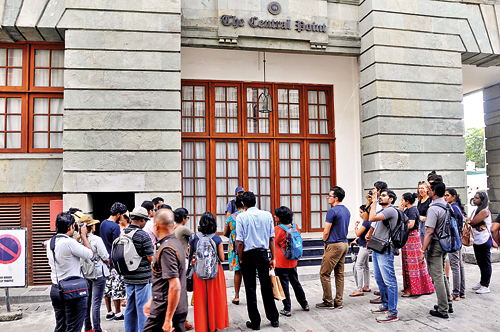The way we were: A walk through the mists of time

A lesson in economics: A recent walk through Fort and right Travis Gomez Pix by Priyantha Wickramaarachchi
Remember those stories your parents and grandparents would relate about how your neighbourhood used to look like when they were growing up? Or about Colombo’s colonial landmarks? Ever wanted to know what it was really like back then? With a little help from Historical Dialogue’s Memory Walk series, you can get to know how some of Sri Lanka’s neighbourhoods were in days gone by. The Memory Walks, that recently reached their 1000th participant, give Lankans the opportunity to walk around a certain neighbourhood and learn all about it.
These free walks are conducted by an expert who has done extensive research about the area. They use everything from heritage sites, old buildings and signs, to old pictures to help participants visualize what once was. The areas are chosen based on the selected guide’s expertise. A maximum of 20 participants take part in each walk. 12 routes have been covered to date – in Colombo, Negombo and even Jaffna. A group of 15-20 people can request a walk to be held for them.
 The Historical Dialogue project began in late 2017 as part of a larger programme by the German Foreign Office (GIZ) called the Strengthening Reconciliation Processes in Sri Lanka. The two main people who oversee every walk are Sulakshana de Mel and Johann Peiris. A social anthropologist, Sulakshana is the Technical Advisor for the Strengthening Reconciliation Processes prgramme in Sri Lanka while Johann, a sociologist, is a Technical Expert of the programme.
The Historical Dialogue project began in late 2017 as part of a larger programme by the German Foreign Office (GIZ) called the Strengthening Reconciliation Processes in Sri Lanka. The two main people who oversee every walk are Sulakshana de Mel and Johann Peiris. A social anthropologist, Sulakshana is the Technical Advisor for the Strengthening Reconciliation Processes prgramme in Sri Lanka while Johann, a sociologist, is a Technical Expert of the programme.
“It’s not just a guided tour – people share their own experiences,” says Sulakshana. “Our target is the general population of Sri Lanka,” says Johann, adding that while foreigners are more than welcome to take part – they aren’t the target audience. They explain how the walks used to elicit many a raised eyebrow as people were confused about their purpose. Now, there is a great demand for the walks, we learn.
 Sulakshana says the walks cover history which books often overlook such as the political history of a country – from the time of the Kings to the British Governors to the Presidents of Sri Lanka and trace the social and economic history of the time and find out how ordinary people lived.
Sulakshana says the walks cover history which books often overlook such as the political history of a country – from the time of the Kings to the British Governors to the Presidents of Sri Lanka and trace the social and economic history of the time and find out how ordinary people lived.
Happy about the success of the walks, the team hopes to have more walks conducted in Sinhala and Tamil. While certain routes are conducted in English and a local language (such as the Jaffna walk in Tamil), Sulakshana says she would like to have all the walks in Sinhala and Tamil irrespective of the area.
For more information, pls see http://historicaldialogue.lk/. They are also on Facebook.
| How Fort became a commercial hub | |
| Did you know that Hatton National Bank literally began in Hatton with the growth of the tea plantations? Or that Sri Lanka used to have banks which issued their own currency before the Central Bank took over? These are some of the interesting facts participants of the latest history walk learnt. Titled ‘Tea to Tech- The Changing Economies of the Colombo Fort’, the walk conducted by Travis Gomez traced the economic history of the Fort area.While the area used to literally be a Fort during the time of the British with no commercial activity being conducted there until the 1870s – when the ramparts were demolished, with the construction of the Suez Canal, which was completed in 1869, global trade became more widespread. Around this time the breakwater of the Colombo Port was constructed by the British and trade and shipping activity began shifting from Galle to Colombo. The Fort area became a commercial hub of activity.Most of the economic activity was centred round the tea plantations, which began in the 1860s after the coffee blight, and banks were established for the purpose of trading tea etc. With the rise in trading, other businesses also began in the Fort area, from textile and gold companies to outlets selling food, the iconic Pagoda tea house and Cargills department store among them and with time also prospered. Gradually, the Colombo Fort area we see now began to emerge. |


